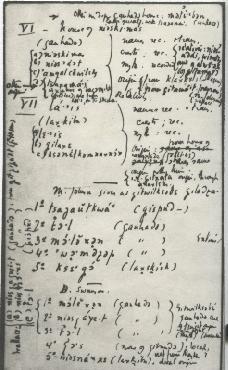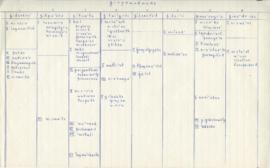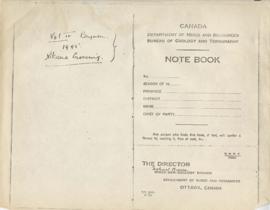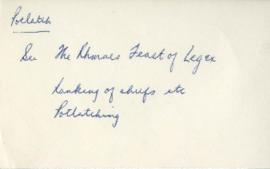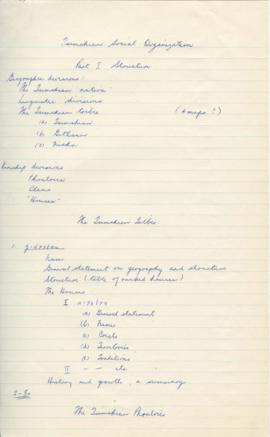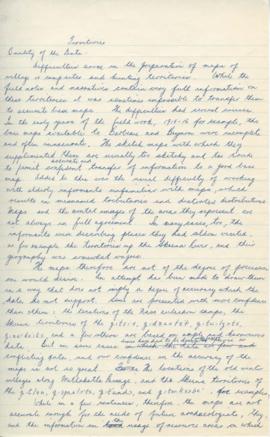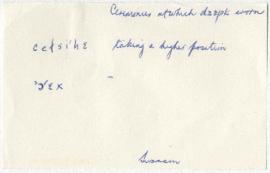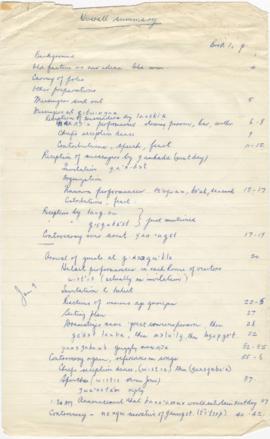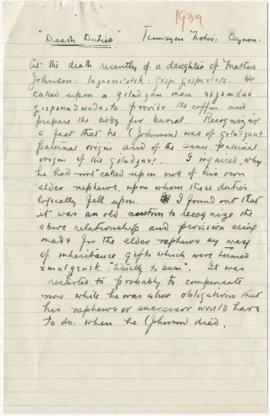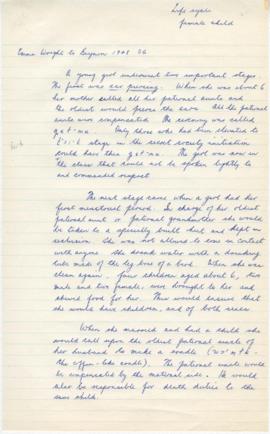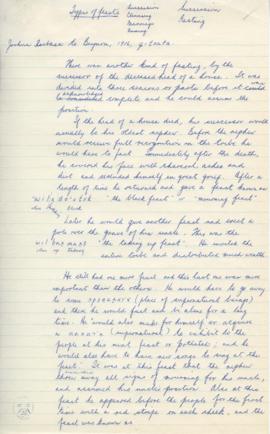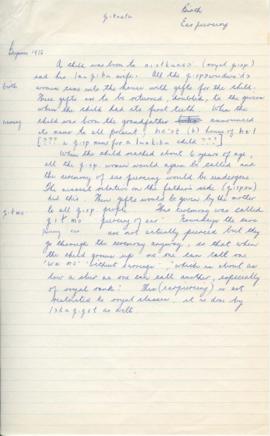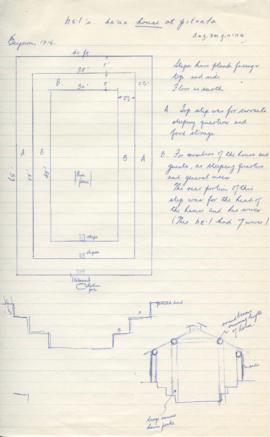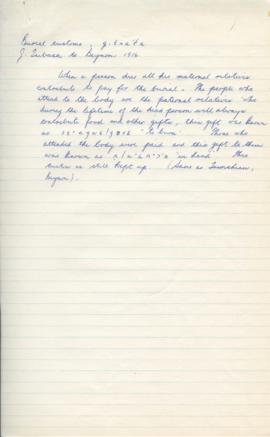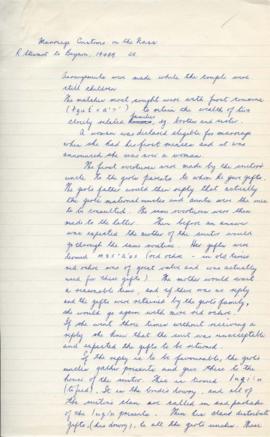Zona do título e menção de responsabilidade
Título próprio
Wilson Duff fonds
Designação geral do material
Título paralelo
Outra informação do título
Título e menções de responsabilidade
Notas ao título
Nível de descrição
Fundo
Código de referência
Menção de edição
Menção de responsabilidade da edição
Menção da escala (cartográfica)
Menção da projecção (cartográfica)
Menção das coordenadas (cartográfico)
Menção da escala (arquitectura)
Autoridade emissora e denominação (filatélica)
Zona de datas de criação
Data(s)
Zona de descrição física
Descrição física
4.81 meters of textual records
ca. 9320 photographic records (photographs, negatives, slides)
70 maps
12 sound reels
7 cassette tapes
1 U-Matic video tape
Zona dos editores das publicações
Título próprio do recurso continuado
Títulos paralelos das publicações do editor
Outra informação do título das publicações do editor
Menção de responsabilidade relativa ao editor do recurso contínuo
Numeração das publicações do editor
Nota sobre as publicações do editor
Zona da descrição do arquivo
Nome do produtor
História biográfica
Wilson Duff was born on March 23, 1925. After serving in the Royal Canadian Air Force as a navigator, Duff attended the University of British Columbia and graduated with a B.A. in 1949. Two years later, in 1951, he completed his M.A. in Anthropology from the University of Washington. Duff’s professional research concentrated primarily on the native cultures of the Northwest Coast and he was instrumental in the development of scholarship in this area. His influence on the study and appreciation of Northwest Coast art was also very profound as he inspired artistic work and in some ways was an artist himself, as evidenced by his poetry and the poetic nature of some of his writing.
In 1950, (prior to being awarded his M.A.) Duff was appointed Curator of Anthropology for the British Columbia Provincial Museum, a position he would hold until 1965. From 1960-1965 he directed the British Columbia Government Anthropology Program. In 1965 Duff left the Museum to become a professor of Anthropology in the Department of Anthropology and Sociology at the University of British Columbia. Throughout his career, Duff maintained a close association with museums and galleries, helping to plan buildings and exhibits, and he was involved in the early stages of planning of the new Museum of Anthropology at the University of British Columbia. Two major exhibits by Duff include “Arts of the Raven” shown at the Vancouver Art Gallery (1967) and “Images Stone B.C.” (1975) shown locally in Vancouver and Victoria before travelling to art galleries across Canada.
Duff was active on a number of committees and he was a founding member of the British Columbia Museums Association where he served as Vice-president from 1962-1963 and as President from 1963-1965. Duff also served on the joint British Columbia Provincial Museum and University of British Columbia Totem Pole Preservation Committee that purchased and salvaged some of the last remaining poles in the Queen Charlotte Islands in the 1950’s. In addition, he chaired the provincial government's Archaeological Sites Advisory Board from 1960-1966 and served on the provincial government's Indian Advisory Committee. During this time he led support for legislation to protect British Columbia’s archaeological remains and worked on the draft of British Columbia’s first “Archaeological and Historic Sites Protection Act” that was passed in 1960. In 1960 Duff acted as a consultant for the Kitwancool tribe and served as an expert witness in the Nishga land case before the B.C. Supreme Court in 1969. That same year, on behalf of the Alaska State Museum and the Smithsonian Institution, he surveyed the totem poles of southwest Alaska. Two years later, in 1971, Duff directed a project to record the history of southeast Alaska Indians for the Alaska State Museum.
Throughout his academic career, Wilson Duff wrote a number of articles, manuscripts and books. From 1950-1956 he was the editor of Anthropology in British Columbia and his first publication in 1953 was based on his Master’s Thesis on the Upper Sto:lo Indians. Published articles and book reviews by Duff can be found in Anthropology in British Columbia no.1, 2, 3, 4, 5; The Crowsnest 9(3); Victoria Naturalist vols. 7, 8, 16(7); B.C. Historical Quarterly, July-October 1951; American Anthropologist vol.54, no.4; Canadian Art 11(2); Anthropology in British Columbia Memoir no.4; Western Museums Quarterly 1(3); Museum Round-up no.12, 16; Anthropologica vol. 6, no.1; B.C. Studies no.3, 19; and Northwest Anthropological Research Notes 3(2). Although many of Duff’s manuscripts remain unpublished, a number of his books are considered to be foremost reference sources in their field. Such publications by Duff include: Thunderbird Park, Victoria B.C., (Government Travel Bureau, 1952), Selected List of Publications Pertaining to the Indians of British Columbia (with J.E.M. Kew, 1956); British Columbia Atlas of Resources (maps 12, 13a, 13b, 1956); Anthony Island, a Home of the Haidas (1957); Histories, territories and laws of the Kitwancool (1959); The Killer Whale Copper (A Chief’s Memorial to His Son (1960); Preserving British Columbia’s Prehistory. Archaeological Sites Advisory Board (1961); Indian History of British Columbia: The Impact of the White Man (1965); Thoughts on the Noot ka Canoe (1965); Arts of the Raven: Masterworks by the Northwest Coast Indians (1967); Indians before the arrival of the white men, the Indians after the arrival of the white men (1967); Indians of British Columbia: Selected Bibliography (1968); Totem Pole Survey of Southeastern Alaska (1969); Bibliography of Anthropology of B.C. (1973); and Images Stone B.C. Thirty Centuries of Northwest Coast Indian sculpture (1975). In 1996, Bird of paradox: the unpublished writings of Wilson Duff was published.
Wilson Duff died August 8, 1976 leaving behind his wife, Marion and his two children, Marnie and Tom. In 1981, “The World is as Sharp as a Knife: An Anthology in Honor of Wilson Duff” was published by the British Columbia Provincial Museum and contained essays, reminisces, artwork, and poetry celebrating Duff’s accomplishments, research and friendships.
História custodial
Wilson Duff's papers were donated to the Museum of Anthropology through a number of accessions. The first series of records came from his wife Marion Duff in 1977 while his son and daughter donated his remaining records between 1983 and 1985. In 2006, there was another donation made by Marnie Duff. This accrual was added to the fonds in 2010.
Âmbito e conteúdo
The Wilson Duff papers consist of textual records, photographs, negatives, slides, maps, audio recordings, compact disks and one video tape that relate to Duff's activities, correspondences, and publications as one of the foremost researchers in Northwest coast Indian history, culture and traditions. Also included in the fonds are records relating to Duff’s work as an Anthropology professor at the University of British Columbia, his advisory and curatorial consultancy work, committee membership and the exhibit Images: Stone: B.C.
Records in the Wilson Duff fonds have been organized into the following seventeen series:
Series 1: Wilson Duff’s student papers (1949-1950)
Series 2: Correspondence (195?-1975)
Series 3: Published and unpublished articles (195?-1972)
Series 4: Site visits (195-)
Series 5: Northwest Coast research (195?-197?)
Series 6: Teaching materials (1965-1976)
Series 7: Committee and consultancy records (1966-1976)
Series 8: Personal records (1965-1976)
Series 9: Photographic records (195?-1976)
Series 10: Maps (1955-1976)
Series 11: Images: Stone: B.C. (1975-1977)
Series 12: Research notes and materials (196?-1976)
Series 13: Tsimshian files (1915-1976, predominant 1957-1971)
Series 14: Recordings (1962-1976)
Series 15: Creative writing (195? - 197?)
Series 16: Posthumous writings on Duff (197? – 199?)
Series 17: Ephemera (195? – 197?)Zona das notas
Condição física
Fonte imediata de aquisição
Organização
The arrangement of the fonds has followed, as much as possible, the order in which the records arrived at the archives. This order may have been imposed by Duff as the creator, although it is possible that family members or Museum staff altered it prior to its arrival at the archives. The 1983 accession arrived in a limited discernable order, so some of the order has been imposed by the archivist.
With the 2006 accrual, there were contents that fell into the pre-existing categories of Northwest Coast native research, Teaching materials, Correspondence, Published and unpublished articles, Personal records, Photographic records, Images: Stone: B.C., and Research notes and materials. Due to the nature of the papers, new Series were created to accommodate the expanded scope and content, including: Creative writing, Posthumous writings on Duff, Ephemera and Architectural plans. Although physically arranged as an accrual, the contents have been intellectually ordered to fit into the existing schema.
Idioma do material
Script do material
Localização de originais
Disponibilidade de outros formatos
A portion of the material in this fonds has been digitized and made available online here.
Additionally, a virtual copy of Series 13 Tsimshian Files has been created by Professor Margaret Seguin Anderson, U.N.B.C. In May 2002, the archives received a draft copy of this work titled “Wilson Duff’s Tsimshian File” which contains scanned copies of Duff’s Tsimshian records on ten compact disks. The compact disks are accompanied by a file list and may be used by researchers in the archives.
Restrições de acesso
Restrictions apply to a number of records in this fonds due to the sensitive nature of the subject matter. Restricted records are noted in the appropriate series description and are also highlighted in the Wilson Duff Series-Box list. The archivist must be consulted before any of these records can be disclosed and made accessible to researchers.
Termos que regulam o uso, reprodução e publicação
The Museum of Anthropology does not hold copyright for all of the records in the fonds, especially Duff’s audio tapes and visual images. At the time of the original donation of the records, copyright did not need to be transferred, but changes to the Canadian copyright law have since set out more explicit requirements governing copyright ownership. Records with restricted use, i.e., undetermined copyright, have been noted in the Wilson Duff Series-Box list. Most of the original negatives for these are found at the Royal BC Museum; others have been found at the American Museum of Natural History. Please consult with these institutions to discuss copyright for use of these particular images.
Instrumentos de descrição
See attached pdf document for finding aid with item level description and file lists.
Instrumento de pesquisa gerado
Materiais associados
Other public bodies with holdings of Duff records include the British Columbia Provincial Museum, UBC's Unisity Archives, and the Archaeology Laboratory, UBC. The British Columbia Archives and Records Service holds microfiche copies of the British Columbia Provincial Museum materials.
Ingressos adicionais
Although no further accruals are expected, audio tapes, photographs and slides may be part of the archives backlog. A backlog inventory has been created and though no Duff records are apparent, they may still be inter-filed with other records.
Conservation
Conservation procedures have been undertaken during the physical processing of the records.
Identificador(es) alternativo(s)
Zona do número normalizado
Número normalizado
Pontos de acesso
Pontos de acesso - Assuntos
Pontos de acesso - Locais
Pontos de acesso - Nomes
Pontos de acesso de género
Zona do controlo
Descrição do identificador do registo
Identificador da instituição
Regras ou convenções
Estatuto
Nível de detalhe
Datas de criação, revisão ou eliminação
update by Lisa Beitel - July 2002
updated by Jen Smith - March 2003
updated by Lindsay Szymanski – September 2010
Revised by Katie Ferrante - December 2015 (added creator authority record and finding aid)

